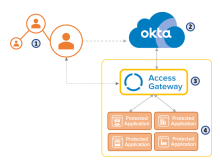Access Gateway apps
Okta Access Gateway apps represent the customer's protected web app assets. When defined within Access Gateway, Okta refers to these definitions as Access Gateway apps, or simply apps.
You can create app definitions using the Access Gateway Admin UI console. All app definitions are similar and require a common set of elements. See Application settings.
When working with Access Gateway apps, you need:
- Users: A set of users, typically maintained within a directory service. They're often managed within your Okta tenant itself.
- Okta org: An Okta tenant.
- Access Gateway: A configured instance of Okta Access Gateway.
- Protected resources: One or more resources.
Other potentially optional elements, such as:
- Firewall: A firewall separating the environment hosting Access Gateway and protected resources.
- Access Gateway High Availability cluster: A group of Access Gateway instances working together to provide a robust high performing environment.
- Load balancer: A load balancer to distribute work load across an Access Gateway cluster.
- Directory service: The source for user profile information.
Restricted cookie field names
The following cookie field names are reserved as Access Gateway uses them for session handling, preventing their use by other apps:
- AuthCookie
- SessionCookie<characterstring>
- spgwAMCookie
- spgwAuthToken
Integration
See these topics for information about integrating apps:
- Generic apps : Integrate header, SAML pass through, Kerberos, portal, WebSocket, and similar apps.
- Sample apps : Integrate and test with sample cookie, header, proxy, and policy apps.
- Third-party apps: Integrate various third-party apps such as Oracle EBS, PeopleSoft, JD Edwards, and others.

